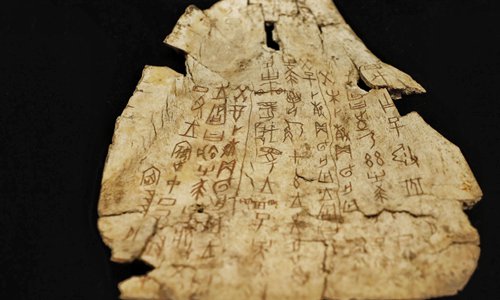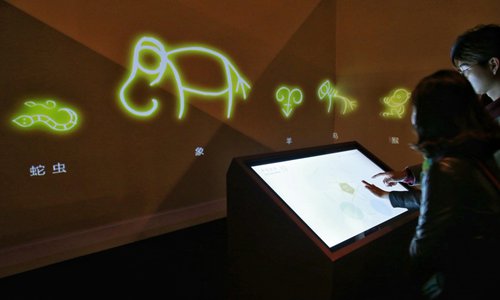HOME >> ARTS
National Museum of China marks 120th anniversary of discovery of ancient oracle bone inscriptions
By Bi Mengying Source:Global Times Published: 2019/10/23 18:38:41

An oracle bone inscription Photo: Li Hao/GT

Visitors explore the oracle bone exhibition at the National Museum of China. Photo: Li Hao/GT
On the middle section of an ox's scapula bone can be seen 22 carved picturesque markings. The scapula, 14 centimeters by 8.5 centimeters, was unearthed in Baoji, Northwest China's Shaanxi Province, more than 40 years ago, but actually dates back to more than 3,000 years ago. As to the markings themselves, while they appear to be fanciful pictures at first glance, they are actually one of the earliest forms of Chinese characters.
While researchers have managed to identify some of the characters used in the inscription, the meaning of the entire passage remains a mystery.
This ancient relic is one of nearly 190 similar items on display at an oracle bone inscription exhibition that kicked off on Tuesday at the National Museum of China in Beijing to mark the 120th anniversary of their discovery.
Predicting the future
While scholars may differ about their exact number, roughly 4,000 Chinese characters have been catalogued from inscriptions spread out on about 130,000 to 170,000 oracle bones unearthed in China, among which the meaning of only about 1,400 to 1,500 of these characters have been identified so far.
Known as jiaguwen in Chinese, this primitive ancestor of today's Chinese characters was carved on tortoise shells and animal bones during divination rights in the Shang Dynasty (1600-1046BC) and early Western Zhou Dynasty (1046-771BC). First excavated from the Yin Ruins (Yin was the last capital of the Shang Dynasty) in Anyang, Central China's Henan Province, oracle bone characters make up the oldest known fully-developed system of writing in China, and are the only ancient writing in the world that has been passed down to the present.
"For the four great ancient civilizations, hieroglyphics from ancient Egypt, cuneiform from ancient Babylon and Mayan glyphs from Mesoamerica, oracle bone inscriptions are the only ones that have survived. They were passed on and evolved into today's Chinese characters," said Wang Chunfa, curator of the National Museum, at the opening ceremony on Tuesday.
The two-month exhibition is divided into three sections: the discovery and creation of oracle bone inscriptions, their use and significance during the Shang Dynasty, and the study of oracle bone inscriptions today.
To provide a fuller picture of Shang Dynasty's civilization reflected by the oracle bone inscriptions, the exhibition also includes bronze wares, pottery and jade to complement with the inscriptions.
This marks the first time that the museum has held such a large-scale exhibition of oracle bones. Along with the collection of the National Museum of China, oracle bone inscriptions collected from other institutions such as the National Library of China, Shandong Museum and Nanjing Museum are also on display.
Historical records
Oracle bone inscriptions are extremely valuable because they provide first-hand accounts of important events and situations in ancient China such as sacrificial and religious ceremonies, wars and military battles, farming and husbandry, even illnesses and births.
During the divination ceremony, the diviner would pose a question, then hold a hot poker to the bones, the high heat would cause cracks to appear throughout the bone, which the diviner would then use to determine the answer to the question.
The inscriptions themselves usually feature three to four parts. The first part usually includes information such as the date, location and participants in the divination, the second includes the question or matter to be divined, while the third features the prediction. The fourth part, when it is included, usually records what actually happened, in other words, if the prediction came true.
One oracle bone, the Tufang Zheng (The Tu Attack), is particularly eye-catching as it features a rather long inscription with all four parts.
With 91 characters on the front and 82 on the back, the inscription reveals that the Shang was attacked by invaders five times over four days.
Attracting visitors
Chinese oracle bone inscriptions were added to the UNESCO Memory of the World Register in 2017, which served as a great opportunity to introduce them to the world and to people beyond scholars, Zhao Aixue, an oracle bone researcher at the National Museum of Classic Books, told the Global Times.
In addition to the ancient relics on display, the exhibition also employs media technologies such as videos, holograms and other interactive experiences for visitors to explore these ancient texts.
For instance, visitors can scan a QR code at the exhibition to download oracle bone inscription emoji on their phones.
"Even though these ancient texts are from more than 3,000 years ago, part of them has passed down as the characters we use today. It would be very meaningful for the public to learn more about the valuable heritage of our culture, which will help to boost our cultural confidence. The National Museum of Classic Books has also been holding exhibitions on oracle bone inscriptions, and it has been our focus to make such exhibitions interesting and accessible, which we find it to be a key to attracting the general public," said Zhao.
Newspaper headline: Divining the past
Posted in: ART,CULTURE & LEISURE